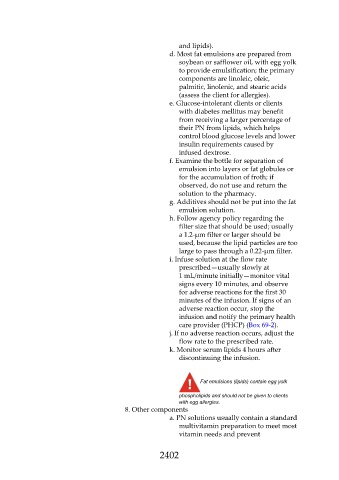Page 2402 - Saunders Comprehensive Review For NCLEX-RN
P. 2402
and lipids).
d. Most fat emulsions are prepared from
soybean or safflower oil, with egg yolk
to provide emulsification; the primary
components are linoleic, oleic,
palmitic, linolenic, and stearic acids
(assess the client for allergies).
e. Glucose-intolerant clients or clients
with diabetes mellitus may benefit
from receiving a larger percentage of
their PN from lipids, which helps
control blood glucose levels and lower
insulin requirements caused by
infused dextrose.
f. Examine the bottle for separation of
emulsion into layers or fat globules or
for the accumulation of froth; if
observed, do not use and return the
solution to the pharmacy.
g. Additives should not be put into the fat
emulsion solution.
h. Follow agency policy regarding the
filter size that should be used; usually
a 1.2-µm filter or larger should be
used, because the lipid particles are too
large to pass through a 0.22-µm filter.
i. Infuse solution at the flow rate
prescribed—usually slowly at
1 mL/minute initially—monitor vital
signs every 10 minutes, and observe
for adverse reactions for the first 30
minutes of the infusion. If signs of an
adverse reaction occur, stop the
infusion and notify the primary health
care provider (PHCP) (Box 69-2).
j. If no adverse reaction occurs, adjust the
flow rate to the prescribed rate.
k. Monitor serum lipids 4 hours after
discontinuing the infusion.
Fat emulsions (lipids) contain egg yolk
phospholipids and should not be given to clients
with egg allergies.
8. Other components
a. PN solutions usually contain a standard
multivitamin preparation to meet most
vitamin needs and prevent
2402

